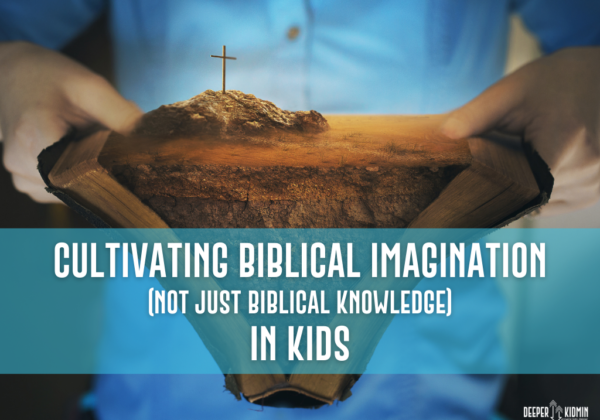
Last week, I joined my friend, Ana Zugheri, on her YouTube channel to talk about creativity as leaders in children’s ministry: how we foster our own creativity, how we balance the organizational and creative sides of a leader’s job, and I even got to talk about Brain Dumps for a bit.
One of my favorite questions Ana asked was about how we help kids be creative. This question fit right in with some research I’ve been doing and what has been on my heart and my mind for a blog post to share, so it was cool to see how God tied it all together!
God is an imaginative God – He had to be, in order to be the Creator God. Think about all of the different plants and animals in the world. Just take a look at this tiny, glowing, “immortal” jellyfish and tell me that doesn’t take some imagination. Or read up about this carnivorous, snake-like plant whose roots can survive a fire. We get our imaginations from the ultimate Imaginer, and we can’t ignore this wonder-full aspect of learning when we teach kids.
Sometimes in children’s ministry, we get so focused on the Biblical knowledge we want kids to learn that we forfeit the development of their Biblical imagination. We may think knowledge and imagination are mutually exclusive, but they’re really 2 sides of the same coin. Imagination spurs a curiosity for knowledge. And in turn, knowledge allows for the expansion of our imagination.
The imagination plays a central role in learning and intellectual development – especially for kids. Experts who research and explore this method of imaginative education define the imagination like this: “It is the ability to think of the possible, not just the actual; it is the source of invention, novelty, and flexibility in human thinking; it is not distinct from rationality but is rather a capacity that greatly enriches rational thinking.”
Too often we treat the Bible as something that we must memorize and defend, and not as a great mystery that we are called to discover and participate in. When we invite that sense of wonder into our teaching, we harness a powerful learning tool that fuels creativity and innovation. Wonder invites questions. Wonder stirs curiosity. It helps them connect their head and their heart by tying in knowledge with emotions.
Wonder helps us see familiar stories in a new light that inspires an internalization of and transformation from the lesson. We can’t just teach kids the stories of the Bible or strip it down in the name of simplicity and life application. We have to help them explore the extraordinary within the stories of the Bible so they can discover the redemption, wonder, and mystery.
So what can we do to incite wonder and encourage Biblical imagination through our teaching?
- Share the story (and the Story) – The word of God is living and active (Hebrews 4:12), and we should teach its stories as, well, stories. This means we should invite kids into the action of the plot to join the people of the Bible on their way to the climax of the story. Think about some of your favorite storytellers and utilize some of their techniques when teaching. (Find 10 interactive storytelling techniques for kids here!) Also try and show the smaller Bible story in light of the overarching Story of the Bible. Where does it fit in? Go beyond just “Old Testament” and “New Testament” or even “before Jesus” or “after Jesus” and talk about how the story fits into God’s redemptive plan. Help kids make connections between the stories and see how they fit together as God’s Big Story, chronologically throughout history.
- Laugh as you learn – The easiest way to reduce boredom and encourage engagement is to make the lesson fun and enjoyable! Include jokes or funny observations about the story. There are lots of things in the Bible that make me laugh. For example: Matthew 4:1-11 tells us that after 40 days of fasting in the desert, “Jesus was hungry.” Ha! I’d be hungry too after 40 days of fasting! This line always makes me laugh, but when I dig deeper into that laughter and seemingly obvious detail, I see that this detail tells us that while Jesus was fully God, he was also fully human. He hungered, he thirsted, he felt pain. The silly “duh” moment leads to a deeper understanding that I can connect with.
- Engage the body – Use gestures, play charades, or invite kids to make faces as to how they would react if they were a person in the story. What pose might represent the different people, cities, places, actions happening in the story? Seek patterns, look for repetitions, or put it to music: “If this part of the story was a drum beat, what would it sound like? If this part of the story was a sound, what would it be?” Speaking of sounds, engage the senses as much as you can. How would different parts of the story feel, touch, taste, smell, or sound? For example: ask kids what they think the ark might have smelled like.
- Connect feelings – Feelings and emotions lead to remembering and learning. Not only does emotion affect attention (kids will pay more attention the stronger they feel about a story), but emotions can actually enhance long-term memory retention. The simplest way to connect feelings is to share a) how you think the people in the Bible story might be feeling (either based on the text or context clues) and b) invite kids to share how they would feel if they were a person in the Bible story.
- Identify the unknown – Present the story as part of a great mystery or adventure. There are lots of things we DON’T know about the Bible, and that’s OK. Draw attention to the unknown or unexplained parts of the story. It’s OK to leave some things unanswered. Unanswered questions help kids learn that faith is a lifelong journey.
- Be filled with wonder yourself – You as the teacher/leader can’t take kids where you have never been yourself. So do your own imaginative deep dive into the Bible story as part of your preparation for teaching the lesson. Rather than jumping straight into the script the curriculum gave you, read the Bible story for yourself. Underline or highlight parts of the story that evoke emotions, make you chuckle, or cause you to wonder about something. If YOU are caught up in the imagination of a story, that will shine through as you teach kids, inviting them to use their creativity and imaginations too.
God can do “immeasurably more than all we ask or imagine” (Ephesians 3:20), and He’s given us minds to think creatively and wonder curiously at His Story. When we intentionally invite wonder into the learning process with kids, we help them cultivate a Biblical imagination that shapes a more robust Biblical knowledge and leads to life transformation.

3 Comments
[…] you know how much I love talking about the imagination and learning. Developing a child’s biblical imagination is a key element of their spiritual development, which is why I am STOKED for the newest Advent […]
These are some great ways to help engage kids, as well as, leaders in the message of God’s word. I do have a concern with using the word, “story” or “stories” as we talk about the content of the Bible. These terms are most often associated with something that may or may not be true. As we teach who God is and What HIs word is, it is important to make the distinction that He is truth and HIs word is true. The Bible gives us the “account” of who God is and all that He has and is doing. I try and use the words “account”, “Bible lesson”, or the phrase “let’s read what the Bible tell us”.
God most certainly can do “immeasurably more than all we ask or imagine” as your article states. I consistently find great resources on this site, and am thankful for your ministry and your heart for God, the Bible, and kids.
God bless you as you continue to serve Him!
Great point, Kelli, about being intentional about the words we use when teaching! While I understand the concern about using the word “Story,” after a lot of prayer and research into the power of storytelling (both in the secular world and in our faith), I’ve landed on being OK with using that word, but being sure to reiterate that the stories in the Bible are true, special, and different from other stories we may read/hear about. I agree with you that kids need to know the difference/distinction, and I’m so glad you brought that up!
Thanks so much for sharing your perspective and helping us nuance this discussion! You rock!